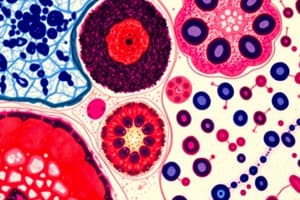Podcast
Questions and Answers
What is the main function of epithelial tissue in the body?
What is the main function of epithelial tissue in the body?
- Provide support and anchoring
- Act as barriers between internal and external environments (correct)
- Transport nutrients and waste products
- Generate movement through contractions
Which type of tissue contracts involuntarily to facilitate movements in digestive tracts and blood vessel walls?
Which type of tissue contracts involuntarily to facilitate movements in digestive tracts and blood vessel walls?
- Epithelial tissue
- Nervous tissue
- Connective tissue
- Muscle tissue (correct)
What is the primary role of connective tissue in the body?
What is the primary role of connective tissue in the body?
- Generating movement
- Absorbing nutrients
- Facilitating secretion
- Providing support and anchoring (correct)
Which type of animal tissue is characterized by contracting through stimulation from nerves?
Which type of animal tissue is characterized by contracting through stimulation from nerves?
What is the primary function of cardiac muscle tissue?
What is the primary function of cardiac muscle tissue?
Which cell type is responsible for oxygen transportation in the blood?
Which cell type is responsible for oxygen transportation in the blood?
What is the function of Langerhans cells in the skin?
What is the function of Langerhans cells in the skin?
Which tissue type facilitates communication, behavior, learning, and memory?
Which tissue type facilitates communication, behavior, learning, and memory?
What is the role of stem cells in bone marrow?
What is the role of stem cells in bone marrow?
Which cell type is critical for plant physiology and provides mechanical strength?
Which cell type is critical for plant physiology and provides mechanical strength?
Flashcards are hidden until you start studying
Study Notes
Delving into Histology: A Study of Tissue Structure and Cell Types
Histology is a branch of biology that focuses on the microscopic study of living organisms' structural organization, particularly their tissues. In this exploration of histology, we will examine two key elements: tissue composition and diverse cell types.
Understanding Tissues
Tissues form the basic unit of structure and function within an organism. They consist of groups of specialized cells with specific functions that work together to perform complex tasks essential for life. There are four main types of animal tissues:
-
Epithelial tissue covers exposed surfaces like skin and lines body cavities and organs such as blood vessels and ducts. These sheets of cells act as barriers between internal and external environments and facilitate absorption, secretion, and protection.
-
Connective tissue provides support and anchoring while also participating in defense, transporting nutrients, waste disposal, and maintaining homeostasis throughout the body. This widely distributed type encompasses loose connective tissue like adipose and dense connective tissue like cartilage and bone.
-
Muscle tissue generates movement by contracting through stimulation from nerves. Skeletal muscle contracts voluntarily during bodily movements, whereas smooth muscles produce involuntary contractions found primarily in digestive tracts and blood vessel walls. Cardiac muscle is another type exclusive to heart tissue and allows it to pump blood efficiently.
-
Nervous tissue transmits information among various parts of the body via electrical impulses across membranes. Neurons transmit signals rapidly along nerve fibers to enable communication, behavior, learning, memory, and more.
Plants possess tissues similar in concept, although different in composition; they have epidermis, ground meristem, vascular bundles, cortex, and pith. These structures facilitate photosynthesis, growth control, water retention, and mechanical strength.
Diverse Cell Types Comprising Animal Tissues
Cellular diversity underlies each tissue type's unique functions. For instance:
- Skin contains keratinocytes, melanocytes, Langerhans cells, Merkel cells, and others that help maintain barrier integrity and respond to environmental factors.
- Blood consists of red blood cells, white blood cells, and platelets, which play essential roles in oxygen transportation, immune response, and hemostasis.
- Bone marrow houses stem cells, lymphoid precursors, and other vital components responsible for the production of blood cells and immunity regulation.
For plants, there are guard cells, chloroplast-containing cells, sieve tube cells, xylem cells, phloem cells, collenchyma cells, and sclerenchyma cells—each playing critical roles in plant physiology.
The beauty of histology lies in its ability to reveal the intricate architecture underlying our bodies' functioning constituent parts, shedding light on how our biological systems operate down to the molecular level. Studying histology thus contributes significantly to medicine, biomedical science, and scientific understanding overall.
Studying That Suits You
Use AI to generate personalized quizzes and flashcards to suit your learning preferences.




